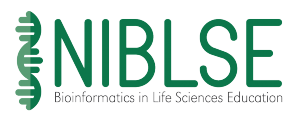Bring Bioinformatics to Your Biology Classroom
Selected Modules
Selected Modules
These are the selected modules for this Faculty Mentoring Network (FMN). During the Spring 2021 semester, participants will adapt and implement at least one of the first three modules associated with Version 5.0 of the learning resource, but are encouraged to implement multiple modules. To access the modules click on the the "Sequence Similarity: An inquiry based and 'under the hood'..." link below. On the following page navigate to the learning resource on CourseSource and log in or sign-up for a free account. Version 5.0 of the learning resource modules will be available via the "Supporting Materials" tab for download.
This laboratory module, published on CourseSource, leads introductory biology students in the exploration of a basic set of bioinformatics concepts and tools.
Description of the Modules
- Module 1: Similarity and Sequence Alignment
- Students start this module by exploring the meaning of sequence similarity and then investigate how similarity can be quantitatively compared between two similar length proteins using a Blocks Substitution Matrix (BLOSUM) scoring matrix. Student understanding of this core concept and competency has utility for biologists seeking to identify conserved blocks of sequence in homologous proteins that may have structural and functional importance and hint at evolutionary relationships between two sequences.
- Module 2: Sequence Alignment to a Database of Sequences
- Students find local regions of similarity between a query sequence and a database of subject sequences using the Basic Local Alignment Search Tool (BLAST) algorithm. Student understanding of this core concept and competency has utility for biologists seeking to identify conserved blocks of nucleotide or protein sequence that may or may not necessarily be homologous, but share common domains (often reused by similar families of proteins) that may hint at structure and function of a protein and hint at evolutionary relationships between two sequences.
- Module 3: Phylogenetic Analysis of Homologous Sequences
- Students practice accessing text-based FASTA-formatted sequence information via National Center for Biotechnology Information (NCBI) databases as they collect protein sequence data for a multiple sequence alignment for the generation of a phylogenetic tree. Student understanding of this core concept and competency has utility for biologists seeking to identify conserved protein domains and often key conserved amino acid residues associated with structure and function within a domain in addition to allowing for visual depiction of evolutionary relationships between three or more sequences.
- Module 4: Inquiry-Based Investigation
- Students apply concepts and competencies from Modules 1-3 to address an authentic biological question. Instructors or students may choose between three investigations involving (1) the evolution of alcohol metabolism in hominids, (2) the evolution of Zika virus, or (3) determining the likely causative agent of an equine corneal ulcer.
